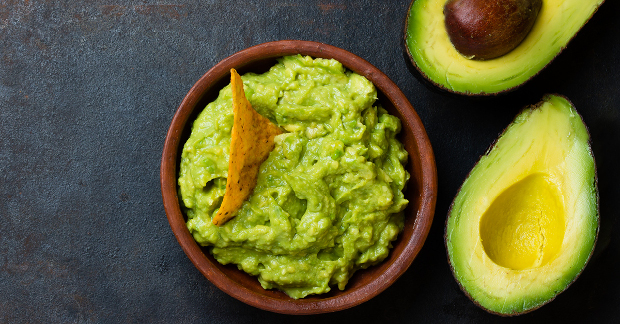


Sign-up for {N}power to get exclusive discounts, newsletters, members-only features, and more!


If I ever find myself wondering about what to bring as a snack for a party or get together, I fall back on the time-tested party favorite—guacamole. Guacamole is without a doubt one of the easiest party snacks to make, yet one of the most absolutely people-pleasing dishes out there. And the best part? Avocados are incredibly good4u.
The avocado (Persea americana) is a berry fruit (yep, it’s a fruit!) with a dark green leathery skin and a very large seed. The first English-language mention of avocado was in 1696. In 1871, avocados were first introduced to the United States in Santa Barbara, California, with trees from Mexico. Compared to other fruits, avocados contain very little sugar[fn value=1][/fn]. One-half an avocado contains only about 0.2 g sugar (e.g., sucrose, glucose, and fructose). The primary sugar found in avocados is a unique and uncommon seven-carbon sugar called D-mannoheptulose which, studies suggest is capable of supporting healthy blood sugar balance and healthy body weight[fn value=2][/fn]. The glycemic index and load of an avocado is about zero.
Once ripened, avocados have an amazing creamy texture provided by the type of fats found within. Much of the fat found in an avocado is the same fat that gives olive oil its reputation as being incredibly healthy, and it’s because of these healthy fats that avocados have a reputation as being incredibly nutritious. Oleic acid, the primary monounsaturated fat found in olive oil, actually increases in concentration as avocados ripen! However, it’s not just the fats in avocados that make it so amazing; avocados supply nearly 20 vitamins, minerals and other beneficial plant compounds to the diet[fn value=3][/fn] . Also beneficial is the fact that avocados have a unique unsaturated fat and water matrix that is perfectly designed to enhance fat-soluble nutrient absorption. Clinical research has demonstrated that adding an avocado to a salad or simply serving avocados with salsa, mixed into guacamole, increases the bioavailability of many fat-soluble compounds by 2–5 times[fn value=4][/fn] .
Some of the beneficial nutrients found in avocado include antioxidants like vitamin E, carotenoids like lutein, a variety of B vitamins, which are important for cellular energy production and gene expression, and much more.
Support a healthy microbial balance in the stomach[fn value=5][/fn]
Support digestive health
Modulate inflammation
Support heart health and healthy cholesterol levels
Support the health of our knees, hips, and bones,[fn value=6][/fn]
Support eye and brain health[fn value=7][/fn]
Furthermore, avocado eaters just seem to be healthier people in general. Studies show that avocado consumers tend to consume significantly more of key shortfall nutrients—dietary fiber, vitamins K, and E, potassium, and magnesium—in their diet than non-avocado consumers. An analysis of data from the National Health and Nutrition Examination Surveys from 2001–2006 suggests that avocado consumers have higher HDL-cholesterol, better cardiovascular health, and a healthier body weight than non-consumers[fn value=8][/fn] .
Jonathan Clinthorne’s love for nutritional sciences stems from his work in a nutritional immunology laboratory at Michigan State University, where he studied the effects of various diets on immune function. While earning his PhD in Human Nutrition, Jonathan had the opportunity to study various other nutritional interventions, such as probiotics, mushroom extracts, and omega-3 fatty acids. He is excited to keep you updated on current research that influences the way that we think about nutrition and food.



Sign-up for {N}power to get exclusive discounts, newsletters, members-only features, and more!